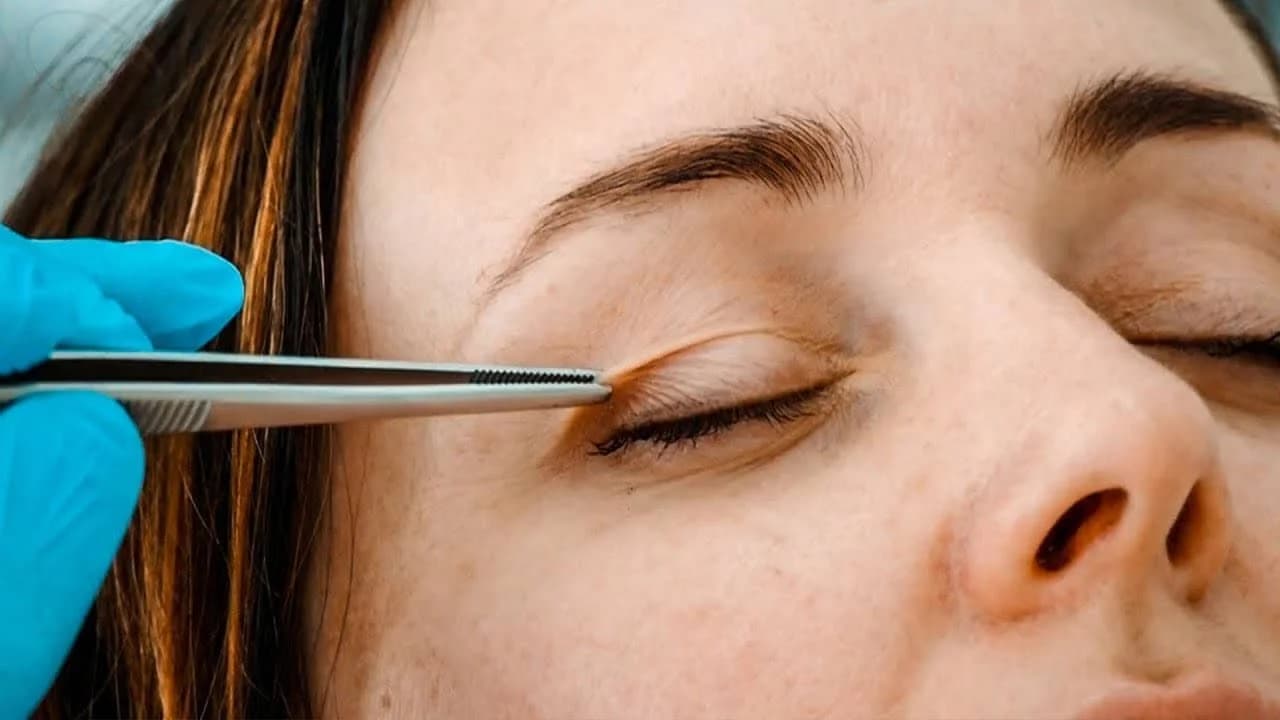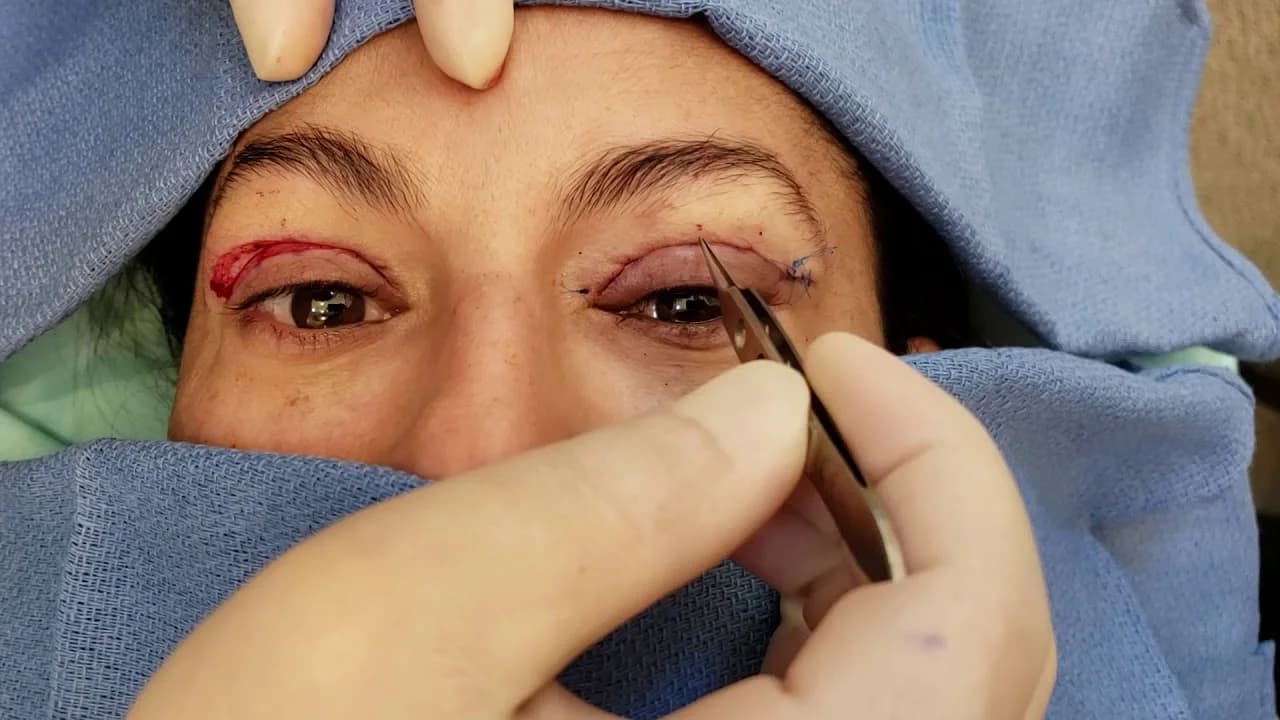Blepharoplasty is a surgical procedure to remove excess skin and muscle (along with underlying fatty tissue) from either or both the upper and lower eyelids. It can improve drooping skin and bagginess and help improve vision in older patients with hooding of their upper eyelids. If you want to learn more about Blepharoplasty, read this article from the Doctour website.
Introduction to Blepharoplasty
Blepharoplasty is a surgical procedure to remove excess skin and muscle (along with underlying fatty tissue) from either or both the upper and lower eyelids. Blepharoplasty can improve drooping skin and bagginess. It can help improve vision in older patients with hooding of their upper eyelids. Although it can add an upper eyelid crease to the Asian eyelid, it will not erase evidence of one’s racial or ethnic heritage. Blepharoplasty will not remove “crow’s feet” or other wrinkles, eliminate dark circles under the eyes, or lift sagging eyebrows. Blepharoplasty surgery is individualized for every patient, depending on his or her particular needs. It can be performed alone involving upper, lower, or both eyelid regions or in conjunction with other surgical procedures of the eye, face, brows, or nose. Eyelid surgery cannot stop the process of aging. It can, however, diminish the look of loose skin and bagginess around the eyelid region.
Alternative Blepharoplasty Treatments
Alternative management forms include not treating the skin laxness and bagginess in the eyelids by surgery. Improvement of skin laxness, fatty deposits, and skin wrinkles may be accomplished by other treatments or surgery, such as the brow lift when indicated. Other forms of eyelid surgery may be needed should you have disorders affecting the function of the eyelid, such as drooping eyelids from muscle problems (eyelid ptosis) or looseness between the eyelid and eyeball (ectropion). Minor skin wrinkling may be improved through chemical skin peels or other skin treatments. Risk and potential complications are associated with alternative forms of treatment.

Risk of Blepharoplasty Surgery
Every surgical procedure involves a certain amount of risk and you must understand the risks involved. An individual’s choice to undergo a surgical procedure is based on the comparison of the risk to the potential benefit. Although the majority of patients do not experience the following complications, you should discuss each of them with your plastic surgeon to make sure you understand the risks, potential complications, and consequences of blepharoplasty surgery.
Bleeding
It is possible, although unusual, to have a bleeding episode during or after surgery. Bleeding may occur under the skin or internally around the eyeball. Should you develop post-operative bleeding, it may require emergency treatment or surgery. Do not take any aspirin or anti-inflammatory medications for ten days before surgery, as this may contribute to a greater risk of a bleeding problem. Hypertension (high blood pressure) that is not under good medical control may cause bleeding during or after surgery. Accumulations of blood under the eyelids may delay healing and increase scarring.
Blindness
Blindness is extremely rare after blepharoplasty. However, it can occur and is associated with internal bleeding around the eye during or after surgery. The occurrence of this is not predictable.
Infection
Infection is very rare after surgery. Should an infection occur, additional treatment including antibiotics may be necessary.
Scarring
Although good wound healing after a surgical procedure is expected, abnormal scars may occur both within the eyelid and deeper tissues. Scars may be an unattractive and different color than the surrounding skin. There is the possibility of visible marks in the eyelid or small skin cysts forming sutures. Additional treatments may be needed to improve scar appearance.
Damage to deeper structures
Deeper structures such as nerves, blood vessels, and eye muscles may be damaged during surgery. The potential for this to occur varies with the type of blepharoplasty procedure performed. Injury to deeper structures may be temporary or permanent.
Dry eye problems
Permanent disorders involving decreased tear production can occur after blepharoplasty. The occurrence of this is rare and not entirely predictable. Individuals who normally have dry eyes may be advised to use special caution in considering blepharoplasty surgery.
Asymmetry
The human face and eyelid region are normally asymmetrical. There can be a variation from one side to the other following blepharoplasty surgery.
Chronic pain
Chronic pain has been reported to occur very infrequently after blepharoplasty.
Skin disorders/skin cancer
A blepharoplasty is a surgical procedure to tighten the loose skin and deeper structures of the eyelid. Skin disorders and skin cancer may occur independently of eyelid surgery.
Ectropion
Displacement of the lower eyelid away from the eyeball is a rare complication. Further surgery may be required to correct this problem.
Cornel exposure problems
Some patients experience difficulties closing their eyelids after surgery and problems may occur in the cornea due to dryness. Should this rare complication occur, additional treatments or surgery and treatment may be necessary.

Unsatisfactory result
There is the possibility of a poor result from eyelid surgery. Surgery may result in unacceptable visible deformities, loss of function, wound disruption, or loss of sensation. You may be disappointed with the results of the surgery. Infrequently, it is necessary to perform additional surgery to improve your results. An additional surgical procedure such as a brow lift may be needed to correct eyebrow sagging which contributed to upper eyelid problems.
Allergic reactions
In rare cases, local allergies to tape, suture material, or topical preparations have been reported. Systemic reactions, which are more serious, may occur to drugs used during surgery and prescription medicines. Allergic reactions may require additional treatment.
Eyelash hair loss
Hair loss is uncommon but may occur in the lower lash area where the skin was elevated during surgery. The occurrence of this is not predictable. Hair loss may be temporary or permanent.
Delayed healing
Wound disruption or delayed wound healing is possible.
Long-term effects
Subsequent alteration in eyelid appearance may occur as the result of aging, weight loss or gain, sun exposure, or other circumstances not related to eyelid surgery. Blepharoplasty surgery does not arrest the aging process or produce permanent tightening of the eyelid region. Future surgery or other treatments may be necessary to maintain the results of blepharoplasty.
Surgical anesthesia
Both local and general anesthesia involve risk. There is the possibility of complications, injury, or even death from all forms of surgical anesthesia or sedation.

Health Insurance
If the hooding of the upper eyelids interferes with your vision, your health insurance company may cover blepharoplasty surgery for the upper eyelids. Most health insurance companies exclude coverage for cosmetic surgical operations such as blepharoplasty or any complications that might occur from surgery. Please carefully review your health insurance subscriber information pamphlet.
Additional Surgery
There are many variable conditions in addition to risk and potential surgical complications that may influence the long-term result of eyelid surgery. Even though risks and complications occur infrequently, the risks cited are the ones that are particularly associated with blepharoplasty surgery. Other complications and risks can occur but are even more uncommon. Should complications occur, additional surgery or other treatments may be necessary. The practice of medicine and surgery is not an exact science. Although good results are expected, there is no guarantee of the results that may be obtained.
Financial Responsibilities
The cost of surgery involves several charges for the services provided. The total includes fees charged by your surgeon; the cost of surgical supplies, anesthesia, and laboratory tests the possible outpatient surgery charges, depending on where your procedure is performed. Even if the cost of surgery is covered by an insurance plan, you will be responsible for necessary co-payments, deductibles, and charges not covered. Additional costs may occur should complications develop from the surgery. Secondary surgery or hospital day-surgery charges involved with revisionary surgery would also be your responsibility.

Conclusion
Blepharoplasty, or eyelid surgery, is performed for both functional and aesthetic reasons. Functionally, it can significantly improve peripheral vision by removing the droopy skin of the upper eyelids that impairs sight. Aesthetically, it rejuvenates the eye area by eliminating excess skin and fat that contribute to a tired or aged appearance. This procedure reflects the intricate interplay between enhancing one's visual function and cosmetic desires, offering a dual benefit that can improve quality of life and boost self-confidence.
Read More: